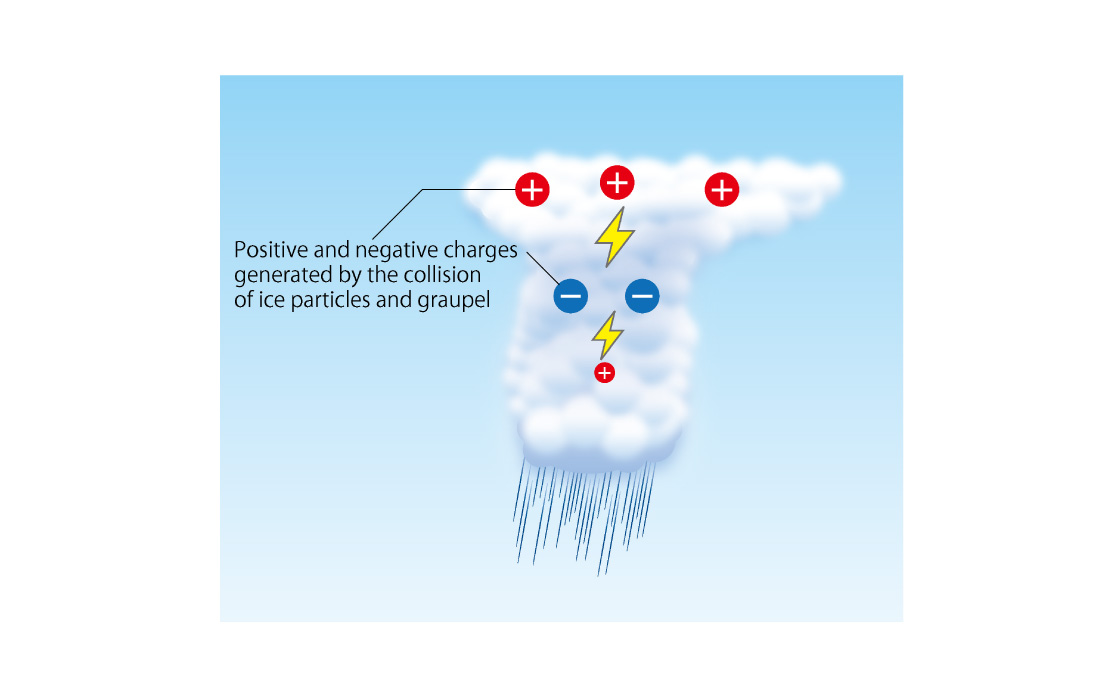Research overview
Without fine particles in the air (aerosols), the formation of clouds becomes very difficult.
To date, cloud simulations have been conducted with the simplification that aerosols required for cloud formation are uniformly distributed. We did not consider the occurrence of lightning in the clouds.
Seeding aerosols is one of the methods to control clouds. However, increasing the concentration of aerosols may lead to problems, such as unexpected heavy rains or lightning. The amount of aerosols can also affect the occurrence location and time, precipitation amount, lightning, and wind speed of cumulonimbus clouds.
We are leading the world in developing a computational program that integrates calculations concerning aerosol and lightning occurrence.
Details of research
On a cold day, the exhaled breath appears white. However, in Antarctica, the exhaled breath does not appear white. Exhaled breath appears white because water vapor exhaled from mouth gathers fine particles, such as dust in the air and condenses into water droplets. These fine particles are called “aerosols.” However, in Antarctica, the air is so clear that there are almost no aerosols; hence, the water vapor cannot gather fine particles, and the breath does not appear white.
When an incense stick is lit, white smoke rises. Minute ash from the burning incense appears, and the ash aerosol collects water vapor in the air, resulting in white smoke. The water droplets that result from the condensation of water vapor and aerosols are the same as the cloud droplets that form clouds.
Given that the amount of water vapor is the same, if the amount of aerosols is small, a large amount of water vapor gathers aerosol, forming a small number of large cloud droplets. Conversely, if the amount of aerosols is large, water vapor disperses and forms a large number of small cloud droplets.
The amount of aerosols can affect the formation of clouds and precipitation amount. The following hypothesis has been proposed regarding the effect of the aerosol amount on the precipitation amount (Fig. 2).
When the amount of aerosols is small, a small number of large cloud droplets are formed, which quickly become raindrops and then fall to the ground. Only a small amount of cumulonimbus clouds was formed because the number of cloud droplets carried to the upper layer was low and the amount of precipitation did not increase.
In contrast, when the amount of aerosols is large, a large number of small cloud droplets are formed and carried to the upper layer, resulting in a higher production of cumulonimbus clouds. The amount of precipitation is also likely to be high.
However, there are objections to this hypothesis, and some researchers believe that the amount of aerosols does not significantly affect cloud development or precipitation. The effect of aerosols on clouds and the precipitation generated from clouds remains poorly understood. To understand this, it is important to use a numerical weather model to reproduce clouds under the conditions of large and small amounts of aerosols and then compare the differences.
However, conventional numerical weather models do not properly consider aerosols. To reproduce clouds, the model divided the atmosphere into grids. For example, a commonly used model calculates clouds by assuming that aerosols are uniform in any grid at the same altitude, and that their amount does not increase or decrease.
In reality, the amount of aerosols varies spatially, and they are blown away by the wind or form cloud droplets. We have developed a numerical model to reproduce clouds by considering the aerosol distribution and its effects.
Efforts to seed aerosols are being made to artificially induce rain in certain areas and prevent rain in other areas. However, seeding aerosols to prevent flood damage may unexpectedly increase precipitation over other areas and cause flood damage.
Reproducing clouds by incorporating aerosols into the calculation is important not only for improving the estimation accuracy of probability but also for predicting the effects of weather control using aerosols.
Lightning damage may also occur because of aerosol seeding. Lightning occurs when ice particles and graupels collide in clouds. In the upper layer of the developed cumulonimbus cloud, water droplets freeze and become ice particles. When an ice particle collides with a graupel, one becomes positively charged, and the other is negatively charged. Subsequently, a layer of positive charges and a layer of negative charges are formed in the cumulonimbus cloud, and lightning is considered to occur between these layers. If the size of the particles constituting the cloud changes, the likelihood of collision will also change. Therefore, aerosols can also affect lightning.
It would be problematic if lightning damage occurs as a result of seeding aerosols. Weather control should be performed after the occurrence of lightning is predicted. However, current weather models do not factor in cloud charge and lightning occurrence. Currently, we focus on developing a numerical model to predict the occurrence of lightning. There are only a few research groups around the world, including ours, who are trying to estimate the occurrence of lightning.
We aimed to develop a computational program to reproduce the generation and development of cumulonimbus clouds and rainfall by integrating aerosol and lightning calculations. To the best of our knowledge, no other research groups have developed such a program. This is because the amount of calculation increases significantly compared with the conventional cloud simulation. It may as well be due to the fact that there are only few researchers interested in both aerosols and lightning.
We plan on devising a model with a reduced amount of calculation, reproducing the occurrence of heavy rain and lightning in the past, and measuring the difference between the calculation results and the observation data. If the difference is large, it may be due to a problem with the calculation method, but it is also possible that factors and mechanisms that are important for cloud formation and development are not included in the calculation. Revealing such unknown factors and mechanisms would be crucial for simulation research.





